Sylvioidea
John Harshman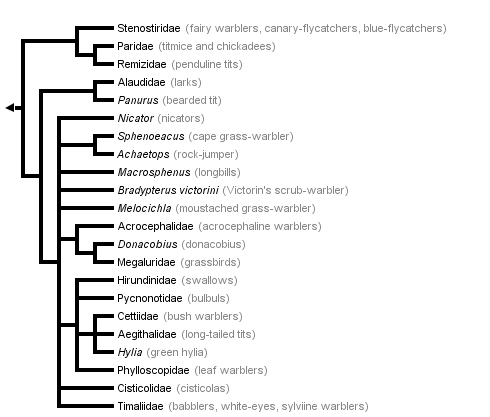


This tree diagram shows the relationships between several groups of organisms.
The root of the current tree connects the organisms featured in this tree to their containing group and the rest of the Tree of Life. The basal branching point in the tree represents the ancestor of the other groups in the tree. This ancestor diversified over time into several descendent subgroups, which are represented as internal nodes and terminal taxa to the right.

You can click on the root to travel down the Tree of Life all the way to the root of all Life, and you can click on the names of descendent subgroups to travel up the Tree of Life all the way to individual species.
For more information on ToL tree formatting, please see Interpreting the Tree or Classification. To learn more about phylogenetic trees, please visit our Phylogenetic Biology pages.
close boxDiscussion of Phylogenetic Relationships
The most difficult problem in establishing sylvioid monophyly has been the inclusion of Paridae (titmice) and its relatives within the superfamily. Though no study has supported that conclusion strongly, several have supported it and none have strongly contradicted it (Sheldon and Gill 1996; Barker et al. 2002, 2004: Beresford et al. 2005; Alström et al. 2006).
In addition to its traditional allies, Remizidae (penduline tits), the clade around Paridae has recently been shown to include a clade of refugees from other families, termed Stenostiridae by Beresford et al. (2005). This clade includes Stenostira (fairy warbler, previously considered a sylviid), Culicicapa (canary-flycatchers, usually considered muscicapid, but placed among petroicids by Sibley and Ahlquist 1990), and Elminia (blue-flycatchers, previously considered monarchids) (Barker et al. 2002, 2004; Beresford et al. 2005; Fuchs et al. 2006).
Monophyly of the remainder of Sylvioidea is strongly supported, though this group differs from that of Sibley and Ahlquist (1990) by inclusion of Alaudidae (larks) (Sheldon and Gill 1996; Barker et al. 2002, 2004; Ericson and Johansson 2003; Alström et al. 2006; Fuchs et al. 2006). Alaudidae, with its unexpected sister taxon Panurus (bearded tit) (Ericson and Johansson 2003; Alström et al. 2006; Fuchs et al. 2006) is strongly supported as the sister group of all remaining sylvioids (Sheldon and Gill 1996, Barker et al. 2002, 2004; Ericson and Johansson 2003; Beresford et al. 2005; Alström et al. 2006; Fuchs et al. 2006). In the rest of Sylvioidea there is a large polytomy consisting of several genera, a few families, and one large group of families. There are still a great many sylvioid (or supposed sylvioid) genera and species yet to be sampled; more sampling of taxa and genes may resolve this polytomy and illuminate unknown clades. Beresford (2005) proposed a “Sphenoeacus group” consisting of Sphenoeacus, Sylvietta, Achaetops, Bradypterus victorini (the genus being polyphyletic), and Macrosphenus; but this was supported only weakly. Other studies, with only partly overlapping taxon samples, have produced contradictory results (Alström et al. 2006; Fuchs et al. 2006). Alström et al. (2006) found Macrosphenus to belong to Pycnonotidae (bulbuls) with strong support; however, the two studies sequenced different species, and it’s quite possible that both are right and the genus is polyphyletic.
The sylvioid polytomy includes four large clades (Alström et al. 2006). Two are the families Cisticolidae (cisticolas) and Timaliidae (babblers). Note that Timaliidae as used here includes the genera Sylvia and Zosterops; there are no families Sylviidae or Zosteropidae, following the terminology of Alström et al. (2006). A third clade includes the families Megaluridae (grassbirds) and Acrocephalidae (acrocephaline warblers) plus the monotypic Donacobius, once considered a troglodytid (Barker 2004; Alström et al. 2006). The final clade consists of a number of families: Hirundinidae (swallows), Pycnonotidae (bulbuls), Phylloscopidae (leaf warblers), Cettiidae (bush warblers), and Aegithalidae (long-tailed tits), plus the genus Hylia (Alström et al. 2006), and the last three form a subclade (Beresford et al. 2005).
References
Alström, P., P. G. P. Ericson, U. Olsson, and P. Sundberg. 2006. Phylogeny and classification of the avian superfamily Sylvioidea. Mol. Phylogen. Evol. 38:381-397.
Barker, F. K., G. F. Barrowclough, and J. G. Groth. 2002. A phylogenetic hypothesis for passerine birds; Taxonomic and biogeographic implications of an analysis of nuclear DNA sequence data. Proc. R. Soc. Lond. B 269:295-308.
Barker, F. K., A. Cibois, P. Schikler, J. Feinstein, and J. Cracraft. 2004. Phylogeny and diversification of the largest avian radiation. Proc. Natl. Acad. Sci. USA 101:11040-11045.
Beresford, P., F. K. Barker, P. G. Ryan, and T. M. Crowe. 2005. African endemics span the tree of songbirds (Passeri): Molecular systematics of several evolutionary "enigmas". Proc. R. Soc. Lond. B 272:849-858.
Ericson, P. G. P., and U. S. Johansson. 2003. Phylogeny of Passerida (Aves: Passeriformes) based on nuclear and mitochondrial sequence data. Mol. Phylogen. Evol. 29:126-138.
Fuchs, J., J. Fjeldså, R. C. K. Bowie, G. Voelker, and E. Pasquet. 2006. The African warbler genus Hyliota as a lost lineage in the oscine songbird tree: Molecular support for an African origin of the Passerida. Mol. Phylogen. Evol. 39:186-197.
Harshman, J. 2007. Classification and phylogeny of birds. Pages 1-35 in Reproductive biology and phylogeny of birds (B. G. M. Jamieson, ed.). Science Publishers, Inc., Enfield, NH.
Sheldon, F. H., and F. B. Gill. 1996. A reconsideration of songbird phylogeny, with emphasis on the evolution of titmice and their sylvioid relatives. Syst. Biol. 45:473-495.
Sibley, C. G., and J. A. Ahlquist. 1990. Phylogeny and classification of birds, Yale U. Press, New Haven.
Title Illustrations

| Scientific Name | Pycnonotus jocosus |
|---|---|
| Location | India |
| Specimen Condition | Live Specimen |
| Source | Red-whiskered Bulbul |
| Source Collection | Flickr |
| Image Use |
 This media file is licensed under the Creative Commons Attribution-NonCommercial-NoDerivs License - Version 2.0. This media file is licensed under the Creative Commons Attribution-NonCommercial-NoDerivs License - Version 2.0.
|
| Copyright | © 2006 Ananda Debnath |
| Scientific Name | Locustella fluviatilis |
|---|---|
| Location | Russia, Moscow, Yauza river |
| Specimen Condition | Live Specimen |
| Source | River Warbler |
| Source Collection | Flickr |
| Image Use |
 This media file is licensed under the Creative Commons Attribution-NonCommercial-NoDerivs License - Version 2.0. This media file is licensed under the Creative Commons Attribution-NonCommercial-NoDerivs License - Version 2.0.
|
| Copyright | © 2006 Sergey Yeliseev |
| Scientific Name | Leiothrix lutea |
|---|---|
| Location | captive at Philadelphia Zoo |
| Specimen Condition | Live Specimen |
| Source | Beautiful |
| Source Collection | Flickr |
| Image Use |
 This media file is licensed under the Creative Commons Attribution-NonCommercial-NoDerivs License - Version 2.0. This media file is licensed under the Creative Commons Attribution-NonCommercial-NoDerivs License - Version 2.0.
|
| Copyright | © 2006 Marty DeAngelo |
About This Page
Correspondence regarding this page should be directed to John Harshman at
Page copyright © 2006
 Page: Tree of Life
Sylvioidea.
Authored by
John Harshman.
The TEXT of this page is licensed under the
Creative Commons Attribution-NonCommercial License - Version 3.0. Note that images and other media
featured on this page are each governed by their own license, and they may or may not be available
for reuse. Click on an image or a media link to access the media data window, which provides the
relevant licensing information. For the general terms and conditions of ToL material reuse and
redistribution, please see the Tree of Life Copyright
Policies.
Page: Tree of Life
Sylvioidea.
Authored by
John Harshman.
The TEXT of this page is licensed under the
Creative Commons Attribution-NonCommercial License - Version 3.0. Note that images and other media
featured on this page are each governed by their own license, and they may or may not be available
for reuse. Click on an image or a media link to access the media data window, which provides the
relevant licensing information. For the general terms and conditions of ToL material reuse and
redistribution, please see the Tree of Life Copyright
Policies.
- First online 02 August 2006
- Content changed 02 August 2006
Citing this page:
Harshman, John. 2006. Sylvioidea. Version 02 August 2006 (under construction). http://tolweb.org/Sylvioidea/67276/2006.08.02 in The Tree of Life Web Project, http://tolweb.org/




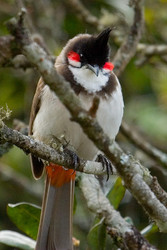
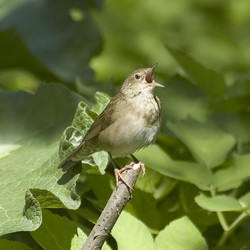
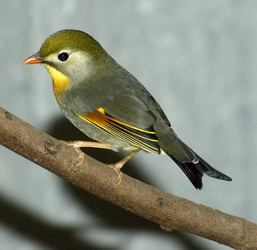


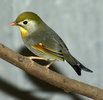


 Go to quick links
Go to quick search
Go to navigation for this section of the ToL site
Go to detailed links for the ToL site
Go to quick links
Go to quick search
Go to navigation for this section of the ToL site
Go to detailed links for the ToL site